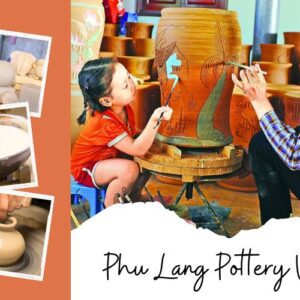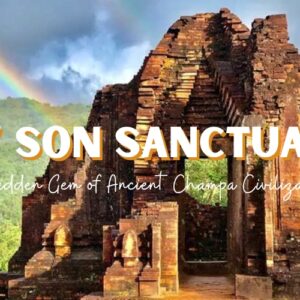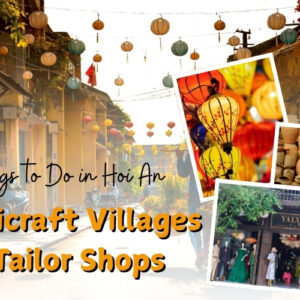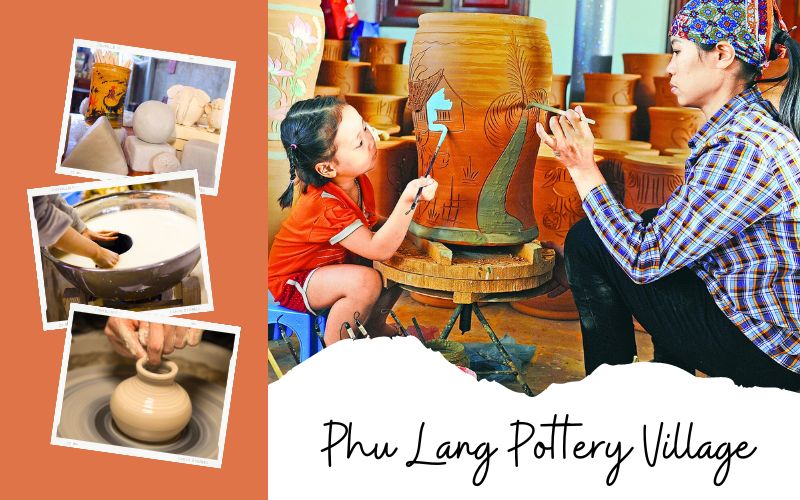
Phu Lang Pottery Village in Bac Ninh province, Vietnam, holds a well-established reputation as a prominent center for pottery production. With its deep-rooted heritage and exceptional craftsmanship, the village has garnered recognition as a cultural gem within the country. Its historical significance spans numerous centuries, making it a fascinating destination for both locals and tourists alike. The village’s exceptional pottery creations have captured the attention of many, contributing to its popularity as a must-visit location.
Location of Phu Lang Pottery Village
Phu Lang Pottery Village is situated in Phu Lang Commune, Que Vo Town, Bac Ninh Province. This beautiful place is approximately 60 km from Hanoi and about 4 km from the Luc Dau River. Positioned along the banks of the Cau River, Phu Lang features numerous docks that facilitate the continuous transportation of passengers. Its roots can be traced back to the transition from the Tran Dynasty to the Le Dynasty, encompassing three distinct hamlets: Middle, Upper, and Lower. Phu Lang enjoys a well-deserved reputation, both nationally and internationally, for its deep-seated tradition of exquisite pottery craftsmanship.
Phu Lang Village’s History
In the book “Kinh Bac – Ha Bac” authored by To Nguyen and Trinh Nguyen, the origins of Phu Lang pottery are attributed to Luu Phong Tu, a prominent figure. During the late Ly Dynasty, he was sent as an envoy to China by the royal court. It was during this visit that he acquired knowledge of pottery making, which he later shared with his fellow countrymen upon his return. Initially, the craft was practiced in residential areas along the banks of the Luc Dau River. Over time, its influence expanded to the Van Kiep region in Hai Duong. As the 13th century ushered in the Tran Dynasty, the art of pottery-making found its way to the land of Phu Lang Trung.
The 14th century, during the Tran Dynasty, marked a period of significant growth and development for Phu Lang pottery. Today, fragments of Phu Lang ceramic artifacts from the 17th to the 19th centuries are carefully preserved and displayed in the Vietnam National Museum of History as well as private collections. These pottery pieces are notable for their distinctive brown glaze, reminiscent of eel skin enamel. They exhibit a range of colors including light yellow, dark yellow, golden brown, and more.
Unique Highlights of Phu Lang Pottery Village
Phu Lang Pottery Village has a rich heritage that dates back hundreds of years. The local artisans have inherited and honed their pottery-making skills from generation to generation, preserving the traditional techniques and artistic styles of Vietnamese ceramics. The village’s pottery products are highly regarded for their quality and beauty. Visiting Phu Lang Pottery Village provides an opportunity to witness the pottery-making process firsthand and learn about the village’s cultural significance. The artisans use locally sourced clay and natural materials to create various pottery items, including vases, jars, bowls, plates, and decorative figurines. These products often feature intricate designs, delicate patterns, and vibrant colors that showcase the artisans’ exceptional craftsmanship.

Phu Lang Pottery Village
In addition to observing the pottery production process, visitors can also engage in hands-on experiences. Many workshops and studios in the village offer pottery classes, allowing visitors to try their hand at creating their own ceramic masterpieces. These classes are a popular choice for both tourists and locals seeking a unique and immersive cultural experience. Exploring the village, you’ll find numerous shops and showrooms where you can purchase authentic Phu Lang pottery pieces as souvenirs or for personal use. The village’s pottery products make excellent gifts and are treasured for their cultural significance and artistic value.
Ceramic Products of Phu Lang
Phu Lang Pottery Village specializes in three main types of ceramics:
- Ceramics for religious purposes: This category includes items such as censers, altars, and peaks that are used in religious rituals and ceremonies.
- Household ceramics: These are everyday pottery items used in households, including jars, vases, pots, lime pots, pipes, and various types of jars. They serve practical purposes in daily life.
- Decorative ceramics: This category consists of ceramics that are primarily used for decorative purposes. Examples include vases and teapots shaped like horses, elephants, and other decorative figures, which you can bring home as a special Vietnam souvenir.
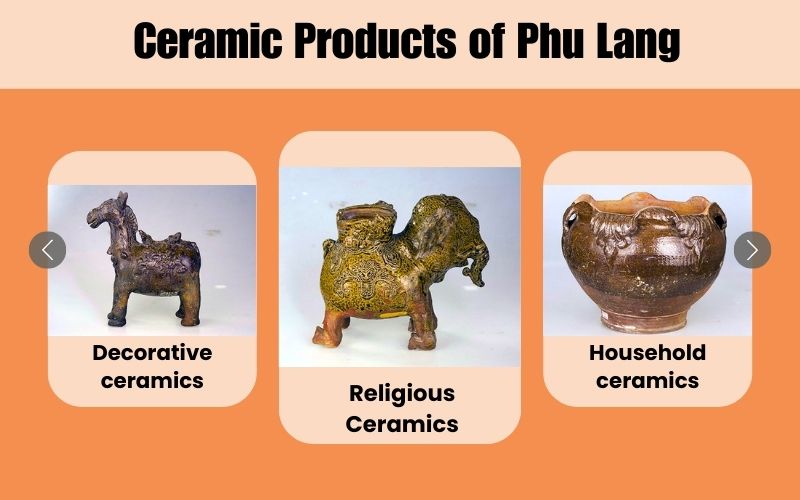
Ceramic products
Phu Lang ceramics are known for their distinctive range of colors, including brown, dark brown, light yellow, dark yellow, and yellow-brown glaze. This unique glaze is commonly referred to as “eel skin glaze.” One of the notable features of Phu Lang pottery is the embossing technique, which involves ball carving or double touch, resulting in a natural and durable enamel color. The pottery’s shapes are characterized by their rustic, rough, and sturdy appearance, reflecting the raw beauty of earth and fire. The pieces also exhibit a strong emphasis on plastic sculpture. When traveling to Phu Lang, visitors will be able to visit all ceramic products of all sizes and types with vibrant colors. From there they can choose to buy for themselves or buy souvenirs for relatives and friends meaningful, affordable, and quality ceramic products.
Outstanding Ceramic Technique of Phu Lang Pottery Village
The ceramic techniques employed in Phu Lang Pottery Village are rooted in the village’s rich history and cultural heritage. The artisans of Phu Lang have honed their skills over generations, preserving traditional techniques while also incorporating their own unique artistic styles. Some of the prominent ceramic techniques practiced in Phu Lang Pottery Village include:
Choosing Soil and Clay Treatment
Phu Lang pottery is a unique type of pottery that is distinct from the ceramic products made in Tho Ha and Bat Trang. While Tho Ha and Bat Trang use green clay and white clay respectively, Phu Lang pottery is made from red and pink soil obtained from the Thong Vat and Cung Khiem regions in Bac Giang province, Vietnam. This allows Phu Lang to preserve the geological structure and landscape of their craft village by avoiding the need to extract clay from their own village.
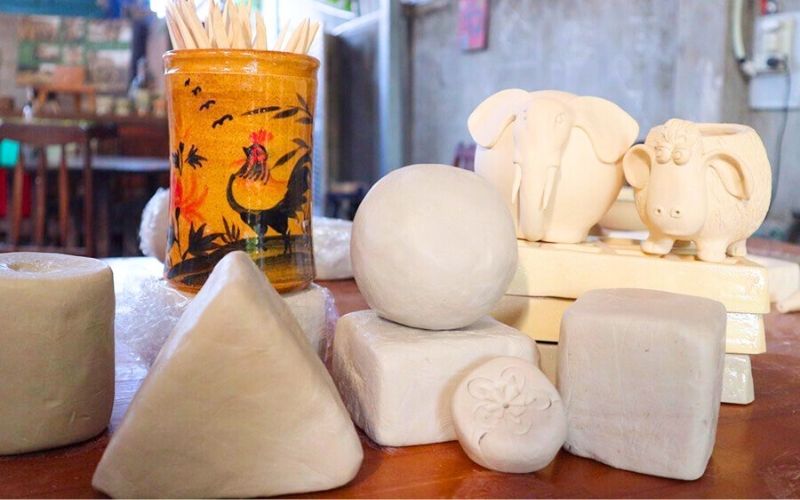
Soil selection and clay treatment
The soil used for making Phu Lang crockery is chosen for its special properties and flexibility. Once the soil is brought back to the workshop, it is dried and mixed. The worker breaks it into small balls using their big toe and then saturates it with water. The soil is then slanted and built up, with the gravel being selected, broken, and removed to achieve a smooth texture resembling a new piece of ham. Before polishing, the piece of ground must be shaped and slanted up to ten times to form a circular shape suitable for the turntable. Skilled craftsmen finely temper the clay, ensuring it has a certain degree of flexibility and smoothness. The clay is then shaped either on a hand turntable or using a mold, depending on the desired product.
Shaping
In Phu Lang pottery, there are various methods of shaping employed to create a wide range of diverse shapes. However, they can generally be categorized into two basic methods. The first method involves shaping a turntable, which is used for household ceramics and decorative pieces. The second method involves printing on wooden or terracotta molds and then assembling the pieces together, often used for creating religious objects. Each type of product and category within Phu Lang Pottery has its own specific techniques and methods, aiming to achieve both economic and aesthetic efficiency.
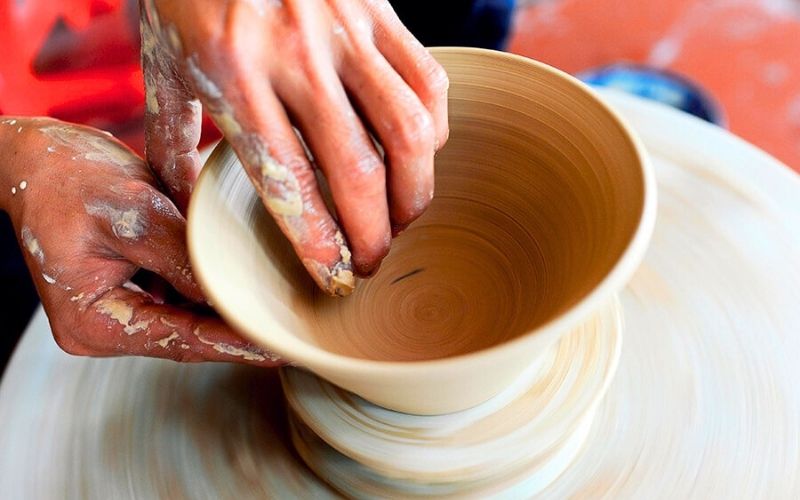
Shaping
Similar to Bat Trang pottery in Gia Lam and Tho Ha in Bac Giang, the broaching method is commonly used for shaping Phu Lang pottery with a circular cross-section. All products are placed on a hand turntable. The process of working on the hand turntable typically involves two people, with one person specializing in polishing and the other rotating the turntable. The person rotating the turntable also rolls the clay into a cylinder called a “blow” or “broach.” Once the product has been shaped, it is allowed to gradually dry and shrink until it is no longer sticky to the touch. The craftsman then punches and pushes the inside of the product to shape it further before letting it dry. If any cracks appear during this stage, they are patched with finely crushed soil. The final step in finishing the product is scraping, which is done once the product has turned silver or white. After scraping, the pottery piece is coated with a layer of enamel to provide color and enhance its appearance.
One of the highlights of the experience is the chance for visitors to actively engage in the creation of ceramic products. At the pottery workshops in Phu Lang, guests can fully unleash their talents, creativity, and imagination while shaping their own unique pieces. This hands-on opportunity allows everyone to immerse themselves in the role of a true potter.
Enameling
Enameling materials encompass various elements, including forest tree ash. This particular type of ash, derived from a tree that yields white ashes resembling lime or cigarette butts when burned, is frequently employed by Phu Lang artisans. Nowadays, these artisans commonly utilize four essential components known as “four irons”: lime, cheesy, tuu, and grind. Additionally, quicklime (lime) serves as another ingredient. Crushed pipe gravel constitutes the third material, while white alluvial mud completes the quartet.
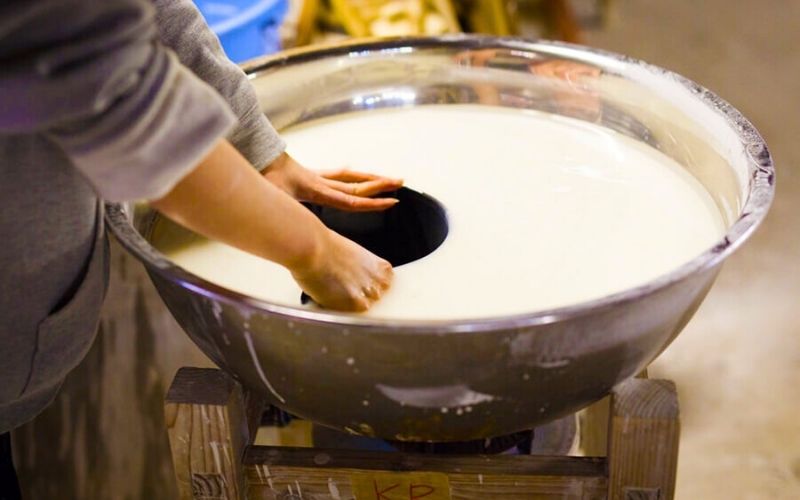
Enamel
After undergoing initial processing, these four materials are combined in specific proportions and allowed to dry. They are then pounded into the water and decanted through a fine sieve, resulting in the creation of a viscous, yellow liquid akin to honey. When the product is still damp, a worker applies a thin layer of this enamel on the product’s exterior using a bristle brush before allowing it to dry. Following the enameling and drying process, the product takes on an opaque white.
Burning
Following the glazing and coloring process, the product undergoes drying before being placed inside a kiln. The kiln is heated to temperatures reaching up to 1,000 degrees Celsius, ensuring that the brown earthenware develops a sharp, smooth, and sturdy outer surface. When stacking the products within the kiln, the principle of maximizing space utilization is followed. A typical kiln can produce around a thousand products and must be fired for three days and three nights. The heat within the kiln gradually increases from the second day until the ceramics reach maturity. They are then allowed to cool before being removed from the furnace. Only at this point does the heating process come to an end, and the products must meet the required standards. Otherwise, they will be deemed unsuitable for use.
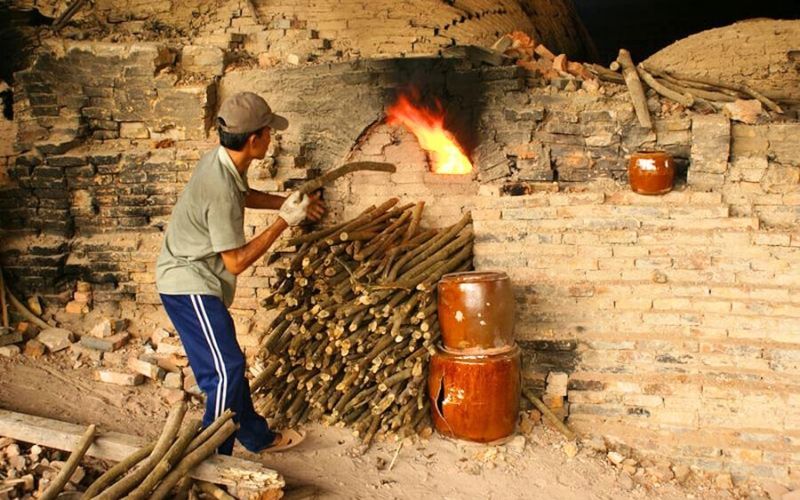
Burning
Despite being located near the coal-rich area of Quang Ninh, the artisans in Phu Lang still adhere to traditional methods, relying on firewood for burning. This method creates unique heat variations that result in distinct markings on the ceramic surface, which cannot be replicated by any other means. The clay used in Phu Lang pottery exhibits a light pink color, which transforms into a chicken liver shade when fired at high temperatures. The two primary glaze colors used are yellow-brown and black-brown, often referred to as eel skin enamel. While the beauty of Bat Trang ceramics lies in their diverse glazes and intricate designs, the essence of Phu Lang pottery stems from the rustic and earthy qualities of its eel skin glaze.
Phu Lang has now become a sought-after destination, attracting tourists from both Vietnam and abroad. Its charm lies in the opportunity to explore the village and its rich pottery heritage. When you visit Phu Lang, you can personally create a unique piece of pottery to offer as a special souvenir to a loved one. The skilled potters of Phu Lang are always ready to extend a warm welcome and guide you through the artistic process. If you have any upcoming plans to visit Phu Lang Pottery Village, feel free to contact us. We are available to assist you with any questions, provide detailed information, and offer helpful recommendations to ensure that your trip to Bac Ninh becomes an unforgettable and enjoyable experience.
